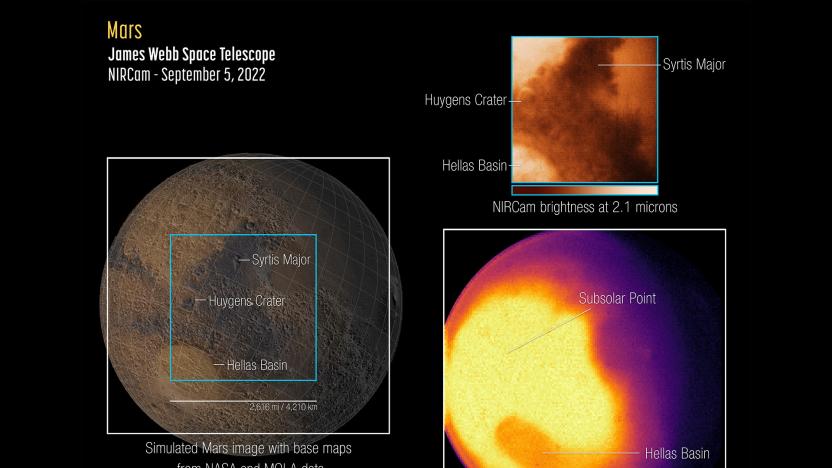spectroscopy
Latest

James Webb telescope captures 'knot' of galaxies in the early universe
A James Webb telescope image has unveiled a 'knot' of galaxies from 11.5 billion years ago.

James Webb Space Telescope's first pictures of Mars could reveal more about the atmosphere
The JWST has captured its first Mars pictures, and they could reveal more about the planet's atmosphere.

Scientists study a 'hot Jupiter' exoplanet's dark side in detail for the first time
Scientists have studied the dark side of a 'hot Jupiter' exoplanet for the first time, revealing likely iron clouds and other surprises.

Scientists find a cloudless 'hot Jupiter' exoplanet with a four-day year
Researchers have discovered a strange Jupiter-like planet that's cloudless and has a four-day year.

World's quickest laser pulse can track electrons in slow motion
The race to produce ever-faster laser pulses has set a new record, and it could lead to breakthroughs in our understanding of atom-level physics. A team at ETH Zurich has shortened an X-ray pulse to just 43 attoseconds (10-18 seconds), which is quick enough that you can observe electrons moving in slow motion. That, in turn, makes it realistic to study extremely fast processes, such as the formation of chemical bonds or the creation of electricity in solar cells.

Massive galaxy cluster found 'hiding' behind the Milky Way
You would think that it would be easy to spot a cosmic structure as enormous as a supercluster holding legions of galaxies, but not so -- the Milky Way can hide all kinds of objects, usually due to dust and stars obscuring the view. If you need proof, you just need to ask the astronomers who have discovered the Vela supercluster, a giant collection of galaxies about 800 million light years away (shown as "VSC" above). They only detected it by making "thousands" of spectroscopic studies of partially obscured galaxies -- it was hidden on the far side of the Milky Way.

X-ray laser spots photosynthesis in real-life conditions
Humanity has known about the life-giving photosynthesis process for a long time, but studying it in real-world conditions has often been impractical. You've typically had to freeze samples to get a good look, which isn't exactly natural. However, the SLAC National Accelerator Laboratory just managed a breakthrough: it used its x-ray laser to capture detailed snapshots of photosynthesis at room temperature. The trick was to place protein complex samples in a solution, put that on a conveyor belt, light it up with a green laser (to start the water-splitting reaction) and capture images using x-ray pulses. As those pulses are extremely fast -- just 40 femtoseconds long -- you can collect crystallization and spectroscopy data before the sample meets its untimely end.

Terahertz scans could save male chicks from an untimely end
Chicken hatcheries often grind up male chicks as soon as they break out of their shells -- they don't produce enough meat as adults, so they're considered useless compared to the egg-laying females. It's not exactly compassionate, and it wastes money as hatcheries incubate eggs they'll never use. However, technology might just have a way to prevent such a horrifying fate. Vital Farms and Novatrans are partnering on TeraEgg, a technology that uses terahertz spectroscopy to identify the sex of a chicken well before it hatches. The technique traps and analyzes the gas emanating from the pores of eggs, identifying the sex (or infertility) within seconds. You can use it as soon as 2 days after the hen lays her eggs, or early enough that you can sell the male eggs as food.

Terahertz laser tech could scan for bombs at airports
Terahertz spectrum scanning is potentially ideal for finding bombs due to the sheer range of materials it can detect, but it's not exactly practical for luggage checks when you need both a suitcase-sized machine and up to half an hour to conduct a scan. MIT researchers have a better way, though: they've developed a quantum cascade laser system that should make terahertz detection a reality. Since the laser's single, tiny frequency comb only consumes power for very brief periods, you can fit it into a part the size of a chip without a gigantic cooling unit -- perfect for airport scanners. It takes as few as 100 microseconds to identify a substance, too, so you wouldn't have to wait (longer than usual, anyway) while agents scan your bags.

The farthest known galaxy is 13.2 billion years old
Scientists have long reckoned that the first galaxies came into being roughly 500 million to 1 billion years after the Big Bang, but finding these ancient celestial bodies is tricky when their light is so faint that even many specialized tools aren't up to the job. However, researchers have managed to spot a galaxy so old that it's making them question the established timeline for the universe. They've determined that the recently discovered EGS8p7 galaxy is a whopping 13.2 billion years old, making it both the farthest known galaxy to date and just 600 million years younger than the universe as we know it. Theoretically, it shouldn't be possible to see the galaxy at all -- in EGS8p7's era, space was supposed to be full of neutral hydrogen clouds that absorbed radiation and made galaxies invisible to later observers.

Exotic quantum laser could help study other planets
Scientists might soon have a much easier time discovering every last nuance of other planets. Researchers have developed a quantum cascade laser (which sounds like an amazing sci-fi weapon, by the way) that can cover a very wide range of infrared wavelengths at the same time, making short work of detecting many chemicals. Astronomers, including study backer NASA, could use it to determine the contents of a planet's surface without touching it -- important when you'd rather not risk breaking samples, or when it's not possible to touch down on the surface in the first place.

iPhone 5 chemical study shows a green Apple, leaves room for improvement
Eventually, that shiny new iPhone 5 will have to meet its untimely end, whether it's in a landfill or (preferably) a recycling company's machinery. When it does, you'll at least be glad to know that Apple has kept the toxin levels down. HealthyStuff and iFixit have dissected the extra skinny smartphone and put it in the same "low concern" category for potential harm that's normally occupied by phones wearing their green credentials on their sleeves. Lest anyone rush to tell Greenpeace about the feat, just remember that there's a difference between proficiency at excising dangerous chemicals and getting rid of them completely: HealthyStuff still found small traces of bromine, chlorine, lead and mercury in the iPhone 5's construction, which could pose risks if the handset is ever broken apart or melted for scrap. Some concern also exists that the x-ray fluorescence spectrometer doesn't reveal the full extent of any toxic materials. Whether or not these remain sore points for you, the new iPhone is at least easier on the eco-friendly conscience than most of its peers.

Artificial tongue distinguishes 18 different types of canned tomato
Taste tests are fun -- unless you're in Italy, in which case they're drawn-out and rancorous. That's why scientists in Milan are trying to remove humans from the equation, by using nuclear magnetic resonance (NMR) spectroscopy to reveal objective "metabolomic fingerprints" for different foodstuffs instead. In their latest experiment, NMR succeeded in predicting how human testers would judge 18 different canned tomato products, including sensory descriptors such as bitterness, saltiness, "redness" and density. Like Caesar always said, technology that knows a good ragu is technology we can trust.

All-optical quantum communication networks nearly realized, 'Answers to Life' airing at 9PM
Ready to get swept away into the wild, wild abyss known as quantum computing? If not, we're certain there's a less mentally taxing post above or below, but for those who answered the call, researchers at the University of California Santa Cruz have a doozie to share. A team of whiz kids at the institution have developed a minuscule optical device that's built into a silicon chip, and it's capable of reducing the speed of light by a factor of 1,200. If you're wondering why on Earth humans would be interested in doing such a thing, here's the long and short of it: the ability to control light pulses on an integrated chip-based platform "is a major step toward the realization of all-optical quantum communication networks, with potentially vast improvements in ultra-low-power performance." Today, data transmitted along optical fibers must still eventually be converted to electronic signals before they're finally understood, but the promise of an all-optical data processing system could obviously reduce inefficiencies and create communication networks that are far quicker and more robust. There's still no telling how far we are from this becoming a reality -- after all, we've been hearing similar since at least 2006 -- but at least these folks seem to be onto something good... even if it's all too familiar.

Infrared and X-ray spectroscopy sheds light on Greek statues' original color schemes
Life in Classical Greece was a lot more colorful than we've been lead to believe by the weather beaten statues seen in school textbooks and on field trips to museums, and conservators have developed a wide array of techniques to determine precisely how these artifacts were once decorated. In addition to using raking light (lighting at extreme angles to reveal subtle changes in the surface of a work, which can reveal where paint was once applied) and UV light (to reveal organic compounds characteristic of older paints), infrared and X-ray spectroscopy can be used to see which wavelengths of light will be absorbed by a material, and which will be reflected. The reflected wavelength tells the researcher (approximately) which color was once applied. And let us tell you, some of these color combos are... eye catching, to say the least. Hit the source link to see for yourself. Update: Thanks to "sir popo" (if that's his real name) for the More Coverage link!

Another breakthrough purportedly brings us closer to quantum computing
In reality, quite a bit of time has passed since we've heard of the next great leap in the (seemingly) never-ending journey towards quantum computing, but we're incredibly relieved to learn that at least someone is still out there, somewhere, pressing on. An international team of researchers have reportedly shown that they can "control the quantum state of a single electron in a silicon transistor, even putting the electron in two places at once." Essentially, the team is using tiny semiconductor transistors to "control the state of a quantum system," but there is still a long ways to go before any of this is meaningful. The crew managed to discover a few things by chance, yet to create a quantum computer, they would need to "position atoms of arsenic (or some other material) in the transistors more reliably." For those of you way too geeked out, fret not -- we'll let you know when all of this technobabble finally amounts to something.[Thanks, Chris]

Futuristic headband knows when you've had too much PC
For those who just can't call it quits, a team of researchers at Tufts University has developed a head adornment which can determine when you've been overly stressed, bored or simply numb to the world around you when using your computer. The crew is studying functional near-infrared spectroscopy (fNIRS) technology, which "uses light to monitor brain blood flow as a proxy for workload stress a user may experience when performing an increasingly difficult task." The band itself utilizes "laser diodes to send near-infrared light through the forehead at a relatively shallow depth," after which it can purportedly judge how intense one's workload is (or isn't). 'Course, we'd guess the most of us wouldn't need a machine to tell us that, eh?[Via InformationWeek]

Handheld meth gun for drug detection
While the hefty yellow gun developed by CDEX Inc. may look like something from a 80s sci-fi film gone bad, it could eventually end up standard fare in a patrol car. Contrary to the title's implication the meth gun does not shoot uppers at what's in its crosshairs. The flamboyant device cracks down on crime by emitting small amounts of UV radiation onto a suspicious surface which causes most illegal substances to release a "spectral fingerprint" which the meth gun identifies. This investigative aid allows cops to detect and identify drug traces without even knowing (or suspecting) that chemical foul play was involved. The finalized version will scan for essentially any drug you can think of trying, but there's a fair amount of red tape and field testing that must be accomplished before this oversized neon pistol gets whipped out on a regular basis. Priced at around $10,000 this drug-buster isn't exactly cheap, but compared to desktop detectors that run upwards of 50 grand, we can envision quite a few precincts placing orders for what CDEX is dealing.


